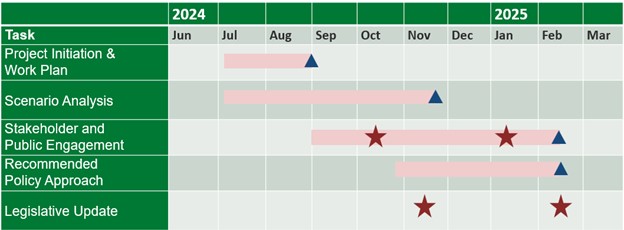The Agency of Natural Resources (ANR) and Vermont Agency of Transportation (AOT) are studying cap-and-invest as a strategy that could support meeting the State’s requirements for cutting climate pollution. Cap-and-invest programs work by placing a declining cap on greenhouse gas emissions and reinvesting the proceeds in climate action, such as energy efficiency, weatherization, and resilience.
The study evaluated the options for joining a cap-and-invest program and the potential benefits and costs of such a program to Vermonters. This work is required by the legislature and happening concurrently with the update to the Climate Action Plan.
Why is the State studying cap-and-invest?
In 2024, the Vermont State Legislature passed Act 148 (the Transportation Bill) which requires the Agency of Natural Resources and Agency of Transportation to study a cap-and-invest program as a strategy that could support meeting the State's requirements for cutting climate pollution. The State must reduce greenhouse gas emissions by 40 percent below 1990 levels by 2030 and 80 percent below 1990 levels by 2050. The transportation sector is responsible for achieving 40% of those required reductions, while the buildings and thermal sector is responsible for just over 30%.
Who is involved?
The Agency of Natural Resources and the Agency of Transportation are coordinating and managing this statewide effort.
The study is guided by a Technical Advisory Committee (TAC), which includes representatives from the Vermont Climate Council, the State Treasurer’s Office, the Agency of Natural Resources, and the Agency of Transportation.
Public and Stakeholder Engagement
The study team is seeking input for the study from members of the public and other stakeholders, including representatives of business, freight, rail, environmental, and equity interests.
Virtual Public Information Meetings
The State is holding two series of virtual public information meetings to hear from members of the public and other interested parties.
- Virtual Public Information - Series 1: October 2024
The project team held two public meetings in early October 2024. Participants were introduced to the study and learned how a cap-and-invest program could help Vermont meet its climate goals, as well as the potential benefits and impacts on Vermonters. Attendees were invited to ask questions and comment on the study.
Watch the recording
Read the meeting summary (PDF)
View the slide deck (PDF)
-
Virtual Public Information Meeting 2: February 2025
On February 10, 2025, the study's findings were shared at a public meeting of the Vermont Climate Council. Watch the recording.
Virtual Focus Group Meetings
Three virtual focus group meetings were held with relevant parties. These included community-based organizations representing equity and environmental interests, potentially obligated industries, and potentially impacted businesses.
- Environment and Community focus group summary (PDF)
- Potentially Obligated Entities focus group summary (PDF)
- Potentially Impacted Businesses focus group summary (PDF)
Study Timeline
The project team is analyzing different cap-and-invest program scenarios and the resulting benefits and impacts to Vermont, including carbon pollution reductions, health benefits, and economic effects for Vermont’s households and businesses. This work will be completed in late 2024, after which the state project team and TAC will identify a recommended policy approach. This will be provided to the legislature for consideration in the 2025 session by the Treasurer’s Office.

